Confidence seems to come naturally to Oliver Glasner — in his own ability and in his team’s. He has changed the mentality at Crystal Palace during his 15 months as their manager and there is a feeling they now go into any game with a good chance of winning it.
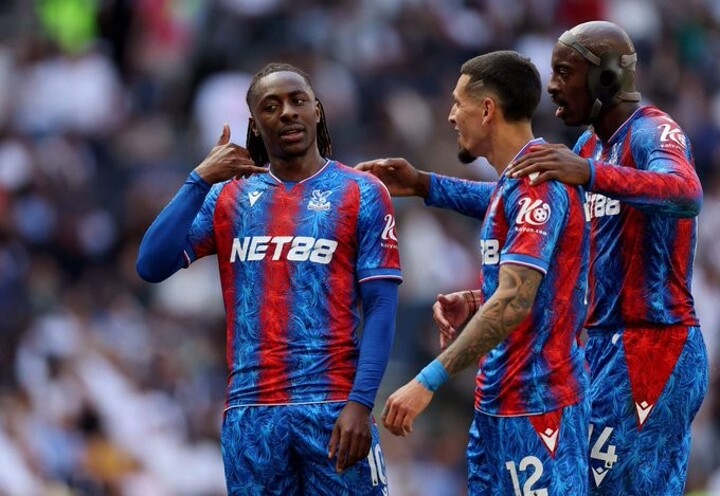
So much so that, following a 5-2 loss against Manchester City last month, Glasner offered words of caution to opposite number Pep Guardiola: “I told Pep after the game that he can’t play this system (again), because we will beat it,” he said, when asked whether he felt his team could avenge that heavy defeat should the teams, semi-finalists at the time, meet again in the FA Cup final — as they will on Saturday.
Before the Wembley showpiece, Palace had to navigate Sunday’s Premier League match at Tottenham Hotspur. The target, Glasner has reiterated, has been to obtain the highest Premier League points total in the club’s history. Their 2-0 win in north London takes them level with Palace’s best haul in the competition, 49, with two games remaining.
They ought to have won more comprehensively — two further goals were disallowed — as they dominated Tottenham’s left flank in particular. The rapid transition play triggered by pressing from the attacking players, which has become a staple under Glasner, was devastating.
It was similar to how they played against City, a game in which they went 2-0 up, with Ismaila Sarr and Daniel Munoz in particular combining down the right. The first of the goals ruled out at Spurs was almost a carbon copy of Eberechi Eze’s opener at the Etihad. Several more similar opportunities followed in the same vein.
Palace go into Saturday’s FA Cup final full of belief, and Glasner will feel his plan is in good shape.
The system he mentioned at the Etihad Stadium last month referred to a recent tweak in City’s shape. Previously, one full-back would tuck into midfield in possession, but of late Guardiola has preferred more traditional, high-and-wide full-backs, with Nico O’Reilly and Matheus Nunes often the first-choice channel runners.
Without the injured Erling Haaland (who did return to the starting line-up after two months out for Saturday’s goalless draw at Southampton), that has created a box-like midfield — Mateo Kovacic and another deeper midfielder at the base, and two creative attacking players at the top — with two wingers or wide No 10s occupying the opposition back line, as we can see here in the early stages that day against Palace:
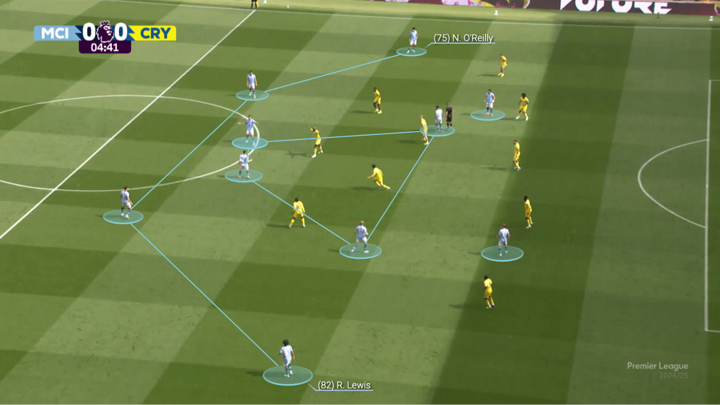
Without the ball, City collapse into something of a 4-2-4, a shape Palace exploited at the Etihad with the width of their wing-backs.
Following a consistent spell of possession, both Munoz and Tyrick Mitchell push on here, helping to quickly turn Palace’s five-man defensive structure into a 3-2-5 with the ball.
Centre-back Maxence Lacroix opens the play up with a ball out to his Colombian colleague down the right-hand side:
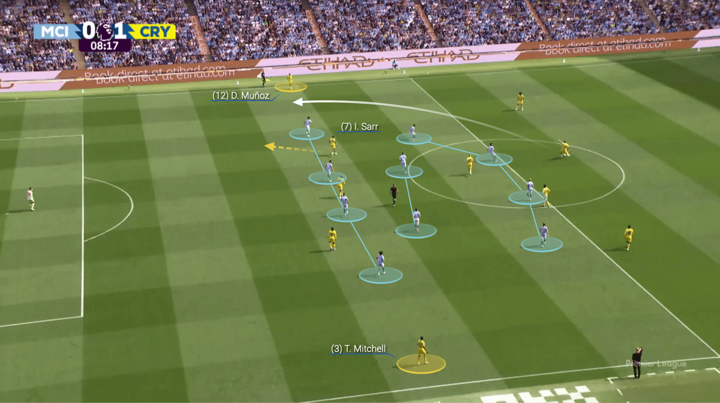
O’Reilly shuffles across to close down the ball, but Josko Gvardiol and midfielder Nico Gonzalez are not quick enough to pick up Sarr, who darts in behind and receives the first-time pass from Munoz:
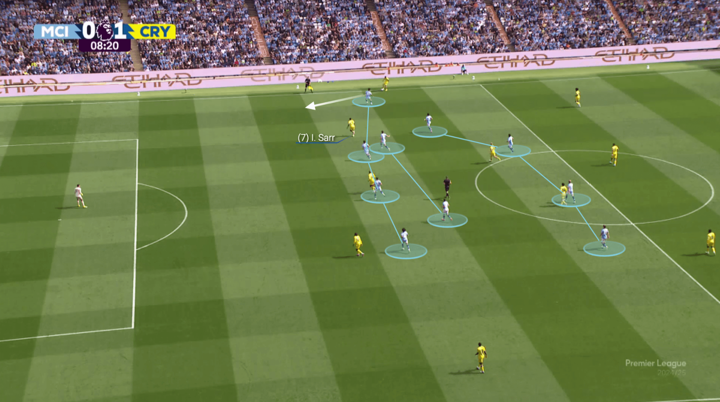
Suddenly, City are exposed, and Sarr squares the ball through for Eze to score.
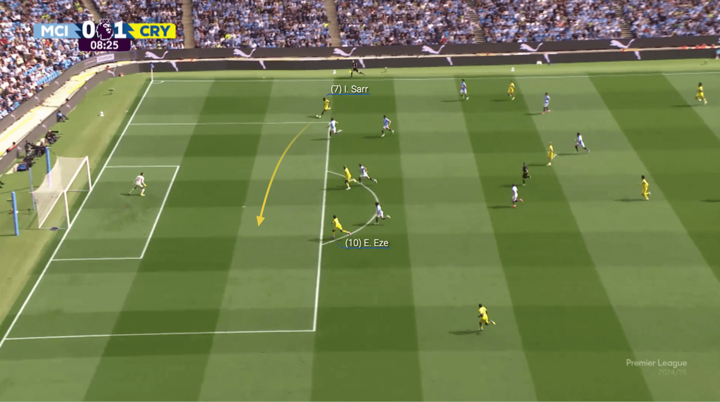
Just over three minutes later, a similar Palace move unfolds.
It’s not quite as neatly constructed as that first one — Mitchell’s crossfield ball is behind Munoz, and Palace’s runners aren’t as prepared to position themselves goalside, but the approach is familiar.
Watch O’Reilly in the clip below. He spots the in-to-out run that caught him for the goal and backs off, before making a split-second decision to step up and pressure Munoz. That moment of uncertainty leaves space behind for Sarr to run into, although his cross is blocked by Gvardiol:
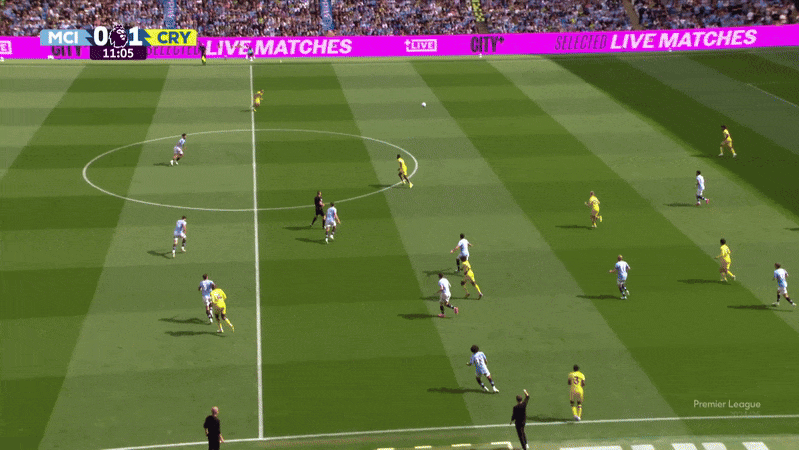
Quick switches of play continued to cause havoc throughout a slick first-half display from Palace.
In this next example, Adam Wharton launches a pass out to the right after a sharp turn in midfield. It shows how continually available Munoz is down the flank with Palace in settled possession, and how quickly they are able to achieve five players bearing down on City’s four across their back line. Tottenham, likewise, found it hard to deal with Munoz’s energy and incision down that wing on Sunday.
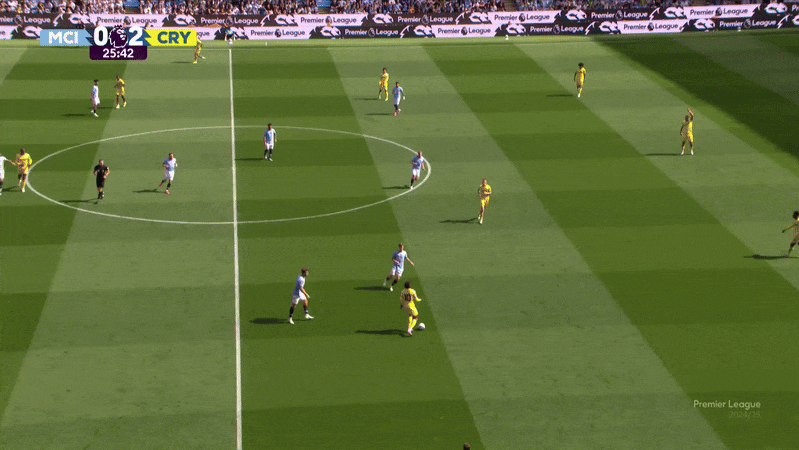
Sarr's run is tracked here, but now it is Daichi Kamada storming forward from midfield to receive that ball down the line. He pulls it back for Sarr, who should do better from close range:
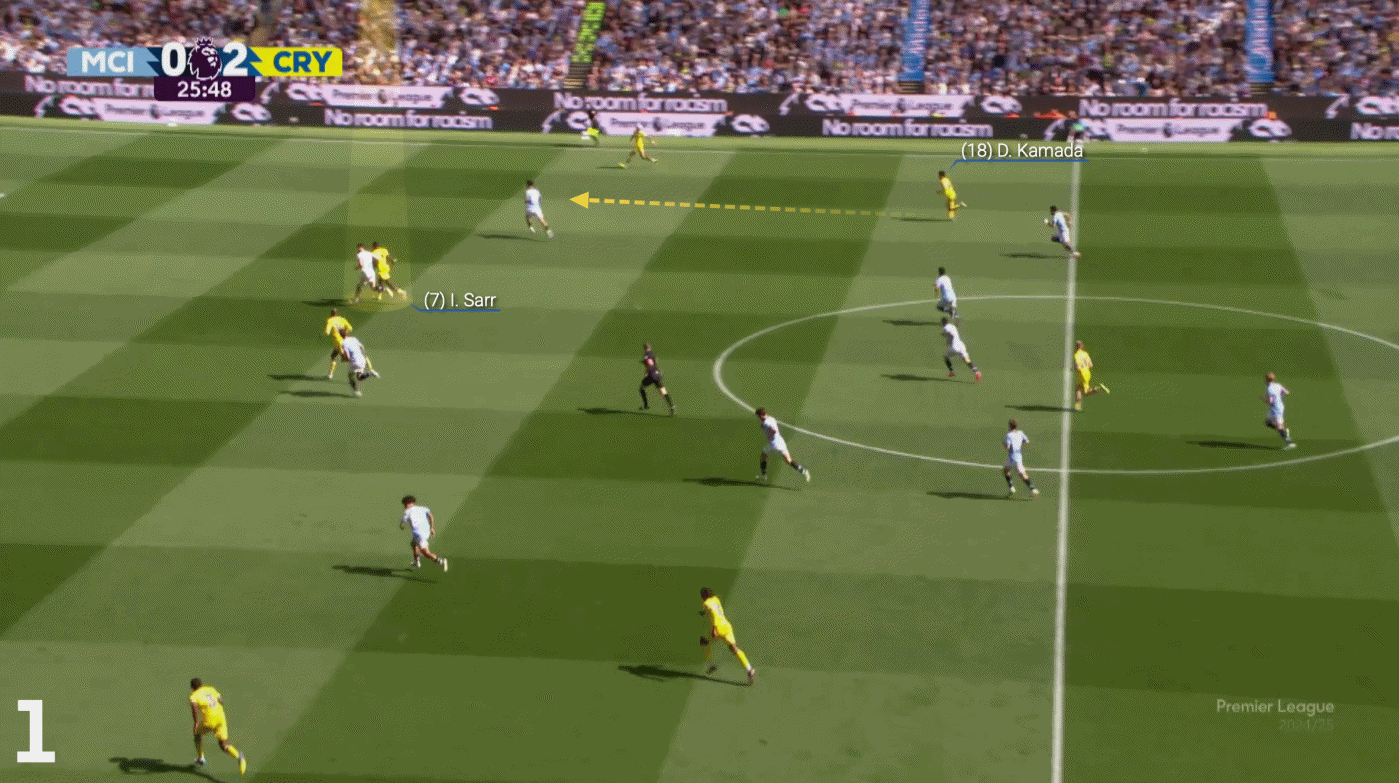
Palace were undone by moments of attacking quality as the game wore on, but there were signs that Glasner’s defensive system is also better suited than others to withstand City’s new approach.
While Nottingham Forest’s 4-4-2 shape was stretched across the pitch in the FA Cup semi-final, with lots of confusion between the wide midfielder and the full-back as to who should cover the flanks, Palace are more capable of matching City’s width with their back five, while having numbers in the middle to compete.
Here in the opening stages of last month’s meeting in Manchester, the front three defend narrowly to stop passes through the middle and Wharton and Kamada patrol behind, with the centre-backs ready to jump forward if required.
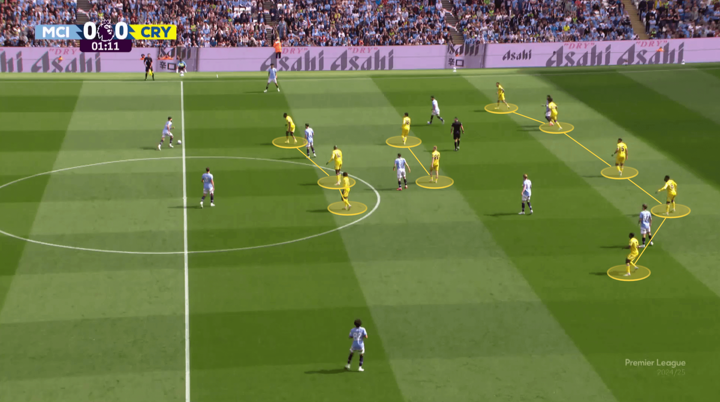
The pass out to the full-back is a clear trigger for Palace’s wing-backs to step forward and engage, which we can see as City move it out to the left. Wharton is already looking across to make sure Mitchell is ready to step up as Ruben Dias opens up his body…
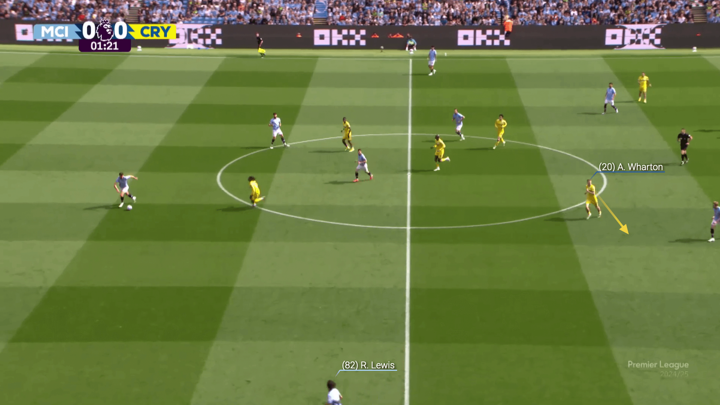
… before he races forward, and forces Rico Lewis back.
Being prepared to step so far forward requires athleticism and commitment, and the rest of the pressing unit are expected to match that, locking on man-for-man and not allowing City to escape.
But such bravery is often what is required to ruffle the feathers of a highly technical, positional side.
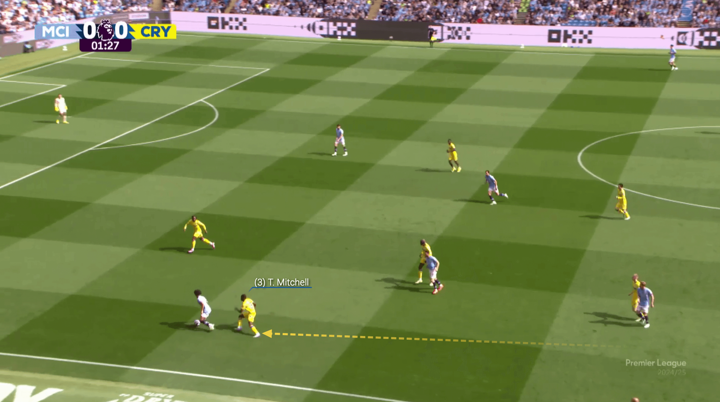
City’s movement and quality can still cause issues, and Palace were susceptible to being pulled out of their shape when opposition midfielders dropped deep.
Below, Kamada feels he has to step up to apply pressure to Kovacic, which means wide centre-back Jefferson Lerma picks up Kevin De Bruyne. That leaves James McAtee free to run in-behind, where his eventual shot is saved by Dean Henderson.
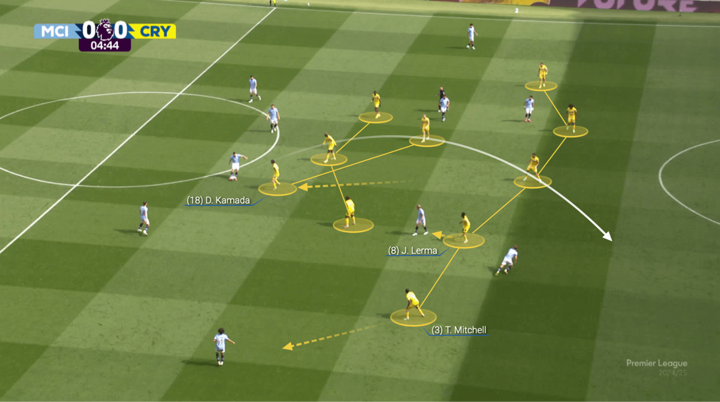
Another 90 minutes (and perhaps more) against City at Wembley will be a significant test of positional discipline and defensive concentration, but Palace’s system, unlike a back four, naturally lends itself to covering their new-found width while maintaining a compact midfield.
Guardiola is never one to rest on his tactical laurels, and the return of Haaland could lead to another tweak in light of Glasner’s comments. City did return to a more controlled approach against Southampton, but struggled to break down one of the worst teams in Premier League history, in points terms, and had to settle for a goalless draw. Flying full-backs could well be back on the menu come the weekend.
Momentum is crucial, especially with Palace’s system, which is predicated on trigger pressing and transitional fluidity. “The best preparation is a good performance here,” Glasner said post-match at Tottenham.
The Palace manager, though, will be encouraged by the way his team have played of late after those difficult defeats by City and Newcastle United (5-0) in mid-April. Even so, there had been encouraging signs in the first half-hour in Manchester. That has now been followed up with a comprehensive win against Spurs, in which they used those same tactics.
Conviction is important, but fail to back up those words last month and Glasner will be seen as needing more humility. Prove his self-belief was well placed by winning the FA Cup and he’ll be viewed as the club’s most successful manager ever.
The stage is set — Palace are in good spirits after yesterday’s victory and now they have a chance to eclipse all that they have done before.
But, Glasner has warned, if they want to win the cup, they will need a better performance than the one at Tottenham.
Confidence has not given way to arrogance.
(Top photo: Julian Finney/Getty Images)
